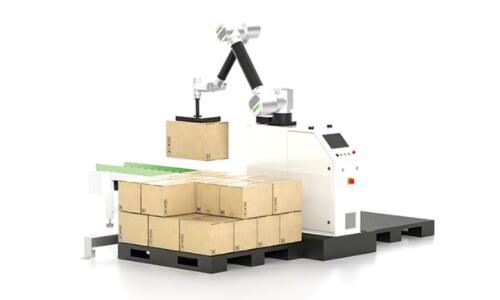Palletizing Robot Industrial Manufacturers
Date: 2023-11-13Id:90Views:

Hot tag:Collaborative robot palletizer,automatic coordinate palletizer,Assemble and move palletizing robot,High Quality,Factory Sales.
Collaborative robot palletizer, also known as a cobot palletizer, is a type of robotic system designed to handle the palletizing process in collaboration with human workers. Unlike traditional industrial robots that often operate in segregated areas for safety reasons, collaborative robots are designed to work alongside humans in shared workspaces.
Collaborative robot palletizer features and considerations:
1. Collaborative Operation:
Cobots are designed to operate in close proximity to human workers without the need for safety cages or barriers. This collaborative operation allows them to work side by side with humans on tasks such as palletizing.
2. Palletizing Process:
The primary function of a collaborative robot palletizer is to pick up items or products from a conveyor or production line and stack them onto pallets. This is commonly used in industries such as manufacturing, logistics, and distribution.
3. Vision Systems:
Collaborative palletizing robots may incorporate vision systems, including cameras and sensors, to identify and locate products on the conveyor or pallet. This enables them to adapt to variations in product size, shape, and orientation.
4. End-of-Arm Tooling:
The end-of-arm tooling is the component attached to the robotic arm that interacts with the products. In palletizing applications, grippers or suction cups are common end-of-arm tools used to pick up and place items.
5. Programming Flexibility:
Collaborative robots are known for their ease of programming. Many cobot palletizers allow for intuitive programming through teach pendant devices or graphical interfaces, allowing users to set up new palletizing tasks quickly.
6. Safety Features:
Safety features are crucial in collaborative robot applications. Cobot palletizers typically include sensors and safety systems that can detect the presence of humans and automatically adjust their behavior to ensure a safe working environment.
7. Payload Capacity:
The payload capacity of a collaborative robot palletizer is the maximum weight it can handle. This capacity varies among different models, and the choice of a robot depends on the weight of the products being palletized.
8. Integration with Conveyor Systems:
Collaborative palletizers are often integrated into existing conveyor systems. They receive products from the conveyor, palletize them, and place the completed pallets back onto the conveyor for further handling.
9. Space Efficiency:
Collaborative robots are often compact and designed for easy integration into existing production spaces. This can be beneficial in facilities with limited floor space.
10. User-Friendly Interface:
Many cobot palletizers feature user-friendly interfaces that make it easy for operators to set up and monitor palletizing tasks.
Collaborative robot palletizers are valuable in scenarios where there's a need for flexibility, adaptability, and collaboration between robots and human workers. They contribute to increased efficiency in palletizing operations while maintaining a safe working environment.
Related


